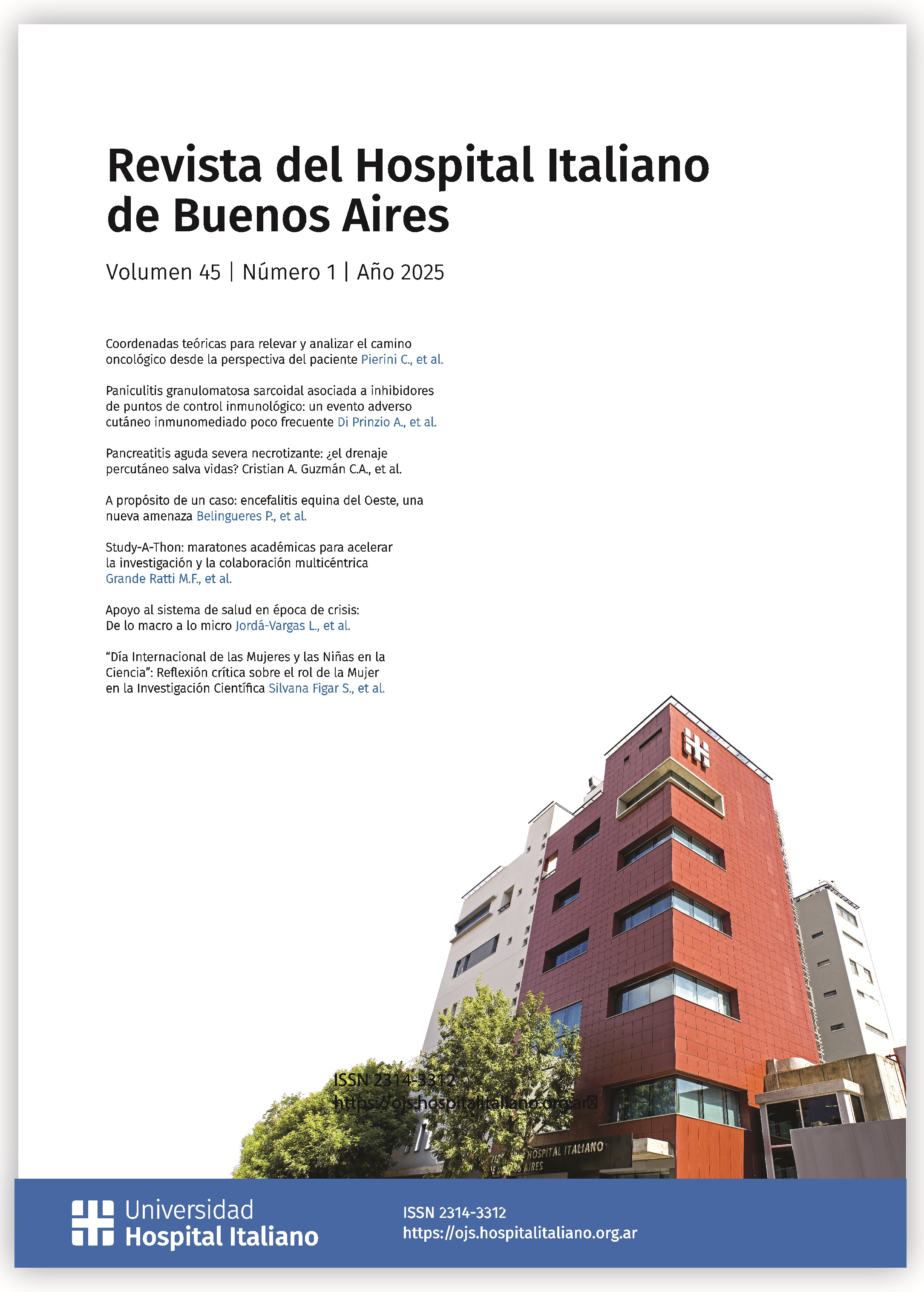Pancreatitis aguda severa necrotizante: ¿el drenaje percutáneo salva vidas?
Contenido principal del artículo
Resumen
La pancreatitis aguda es una inflamación del páncreas que destruye las células acinares. Su incidencia ha aumentado globalmente, sobre todo debido a litiasis biliar y alcoholismo. Este informe describe a un hombre de 58 años con antecedentes de alcoholismo que desarrolló pancreatitis aguda tras consumir alimentos grasos y alcohol. Inicialmente manejado de forma conservadora, presentó complicaciones que requirieron ingreso en Unidad de Cuidados Intensivos (UCI.) La tomografía computarizada (TC) reveló múltiples colecciones necróticas, manejadas mediante drenaje percutáneo guiado por TC. Tras cinco semanas, el paciente mostró mejoría significativa, lo que permitió retirar los catéteres y decidir su alta médica con seguimiento ambulatorio. Este caso destaca el “Step-Up Approach”, que favorece técnicas mínimamente invasivas, como el drenaje percutáneo en lugar de la necrosectomía abierta en pancreatitis grave necrotizante, mejorando la supervivencia y reduciendo complicaciones. El manejo multidisciplinario es esencial para optimizar los resultados clínicos.
Downloads
Detalles del artículo
Sección

Esta obra está bajo una licencia internacional Creative Commons Atribución-NoComercial-CompartirIgual 4.0.
Cómo citar
Referencias
Muñoz D, Medina R, Botache WF, et al. Pancreatitis aguda: puntos clave. Revisión argumentativa de la literatura. Rev Colomb Cir. 2023;38(2):339-351. https://doi.org/10.30944/20117582.2206. DOI: https://doi.org/10.30944/20117582.2206
Zheng Z, Ding YX, Qu YX, et al. A narrative review of acute pancreatitis and its diagnosis, pathogenetic mechanism, and management. Ann Transl Med. 2021;9(1):69. https://doi.org/10.21037/atm-20-4802. DOI: https://doi.org/10.21037/atm-20-4802
Bhakta D, de Latour R, Khanna L. Management of pancreatic fluid collections. Transl Gastroenterol Hepatol. 2022;7:17. https://doi.org/10.21037/tgh-2020-06. DOI: https://doi.org/10.21037/tgh-2020-06
Yang Y, Zhang Y, Wen S, et al. The optimal timing and intervention to reduce mortality for necrotizing pancreatitis: a systematic review and network meta-analysis. World J Emerg Surg. 2023;18(1):9. https://doi.org/10.1186/s13017-023-00479-7. DOI: https://doi.org/10.1186/s13017-023-00479-7
van Santvoort HC, Bakker OJ, Bollen TL, et al. A conservative and minimally invasive approach to necrotizing pancreatitis improves outcome. Gastroenterology. 2011;141(4):1254-1263. https://doi.org/10.1053/j.gastro.2011.06.073. DOI: https://doi.org/10.1053/j.gastro.2011.08.012
Khizar H, Zhicheng H, Chenyu L, et al. Efficacy and safety of endoscopic drainage versus percutaneous drainage for pancreatic fluid collection; a systematic review and meta-analysis. Ann Med. 2023;55(1):2213898. https://doi.org/10.1080/07853890.2023.2213898. DOI: https://doi.org/10.1080/07853890.2023.2213898
Song Y, Lee SH. Recent treatment strategies for acute pancreatitis. J Clin Med. 2024;13(4):978. https://doi.org/10.3390/jcm13040978. DOI: https://doi.org/10.3390/jcm13040978
Baron TH, Thaggard WG, Morgan DE, et al. Endoscopic therapy for organized pancreatic necrosis. Gastroenterology. 1996;111(3):755-764. https://doi.org/10.1053/gast.1996.v111.pm8780582. DOI: https://doi.org/10.1053/gast.1996.v111.pm8780582
Freeny PC, Hauptmann E, Althaus SJ, et al. Percutaneous CT-guided catheter drainage of infected acute necrotizing pancreatitis: techniques and results. AJR Am J Roentgenol. 1998;170(4):969-975. https://doi.org/10.2214/ajr.170.4.9530046. DOI: https://doi.org/10.2214/ajr.170.4.9530046
van Baal MC, van Santvoort HC, Bollen TL, et al. Systematic review of percutaneous catheter drainage as primary treatment for necrotizing pancreatitis. Br J Surg. 2011;98(1):18-27. https://doi.org/10.1002/bjs.7304. DOI: https://doi.org/10.1002/bjs.7304
Navalho M, Pires F, Duarte A, et al. Percutaneous drainage of infected pancreatic fluid collections in critically ill patients: correlation with C-reactive protein values. Clin Imaging. 2006;30(2):114-119. https://doi.org/10.1016/j.clinimag.2005.09.026. DOI: https://doi.org/10.1016/j.clinimag.2005.09.026
Bala M, Almogy G, Klimov A, et al. Percutaneous "stepped" drainage technique for infected pancreatic necrosis. Surg Laparosc Endosc Percutan Tech. 2009;19(4):e113-118. https://doi.org/10.1097/SLE.0b013e3181a9d37d. DOI: https://doi.org/10.1097/SLE.0b013e3181a9d37d
Baudin G, Chassang M, Gelsi E, et al. CT-guided percutaneous catheter drainage of acute infectious necrotizing pancreatitis: assessment of effectiveness and safety. AJR Am J Roentgenol. 2012 ;199(1):192-199. https://doi.org/10.2214/AJR.11.6984. DOI: https://doi.org/10.2214/AJR.11.6984
Bang JY, Arnoletti JP, Holt BA, et al. An endoscopic transluminal approach, compared with minimally invasive surgery, reduces complications and costs for patients with necrotizing pancreatitis. Gastroenterology. 2019;156(4):1027-1040.e3. https://doi.org/10.1053/j.gastro.2018.11.031. DOI: https://doi.org/10.1053/j.gastro.2018.11.031
Baron TH, DiMaio CJ, Wang AY, et al. American Gastroenterological Association Clinical Practice Update: management of pancreatic necrosis. Gastroenterology. 2020;158(1):67-75.e1. https://doi.org/10.1053/j.gastro.2019.07.064. DOI: https://doi.org/10.1053/j.gastro.2019.07.064

